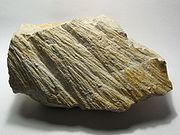
Shatter cone
Encyclopedia

Bedrock
In stratigraphy, bedrock is the native consolidated rock underlying the surface of a terrestrial planet, usually the Earth. Above the bedrock is usually an area of broken and weathered unconsolidated rock in the basal subsoil...
beneath meteorite
Meteorite
A meteorite is a natural object originating in outer space that survives impact with the Earth's surface. Meteorites can be big or small. Most meteorites derive from small astronomical objects called meteoroids, but they are also sometimes produced by impacts of asteroids...
impact crater
Impact crater
In the broadest sense, the term impact crater can be applied to any depression, natural or manmade, resulting from the high velocity impact of a projectile with a larger body...
s or underground nuclear explosions
Underground nuclear testing
Underground nuclear testing refers to test detonations of nuclear weapons that are performed underground. When the device being tested is buried at sufficient depth, the explosion may be contained, with no release of radioactive materials to the atmosphere....
. They are evidence that the rock has been subjected to a shock with pressures in the range of 2-30 GPa.
Shatter cones have a distinctively conical shape that radiates from the top (apex) of the cones repeating cone-on-cone in large and small scales in the same sample. Sometimes they're more of a spoon shape on the side of a larger cone. In finer-grained rocks such as limestone
Limestone
Limestone is a sedimentary rock composed largely of the minerals calcite and aragonite, which are different crystal forms of calcium carbonate . Many limestones are composed from skeletal fragments of marine organisms such as coral or foraminifera....
, they form an easy to recognize "horsetail" pattern with thin grooves (striae). Coarser grained rocks tend to yield less well developed shatter cones, which may be difficult to distinguish from other geological formations such as slickensides. Geologists have various theories of what causes shatter cones to form, including compression by the wave as it passes through the rock or tension as the rocks rebound after the pressure subsides. The result is large and small branching fractures throughout the rocks.
Shatter cones can range in size from microscopic to several meters. The largest known shattercone in the world (more than 10 metres in length) is located at the Slate Islands
Slate Islands (Ontario)
The Slate Islands archipelago is formed of two main islands, five minor islands and numerous islets located in northern Lake Superior, 10 km south of the town of Terrace Bay. The islands were created by a meteorite impact which formed a crater about wide. In 1985, the Ontario government...
in Terrace Bay, Ontario, Canada. The azimuths of the cones's axes typically radiate outwards from the point of impact, with the cones pointing upwards and toward the center of the impact crater, although the orientation of some of the rocks have been changed by post-cratering geological processes at the site.
External links
See also
- BrecciaBrecciaBreccia is a rock composed of broken fragments of minerals or rock cemented together by a fine-grained matrix, that can be either similar to or different from the composition of the fragments....
- CoesiteCoesiteCoesite[p] is a form of silicon dioxide SiO2 that is formed when very high pressure , and moderately high temperature , are applied to quartz. Coesite was first synthesized by Loring Coes, Jr., a chemist at the Norton Company, in 1953. In 1960, coesite was found by Edward C. T...
- LechatelieriteLechatelieriteLechatelierite is silica glass, amorphous SiO2. One common way in which lechatelierite forms naturally is by very high temperature melting of quartz sand during a lightning strike...
- Shocked quartzShocked quartzShocked quartz is a form of quartz that has a microscopic structure that is different from normal quartz. Under intense pressure , the crystalline structure of quartz will be deformed along planes inside the crystal...
- StishoviteStishoviteStishovite is an extremely hard, dense tetragonal form of silicon dioxide. It was long considered the hardest known oxide; however, boron suboxide has recently been discovered to be much harder...

